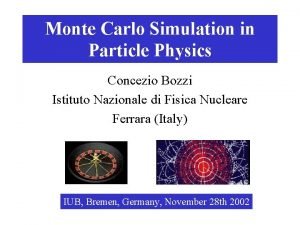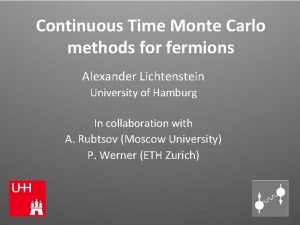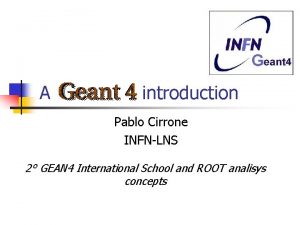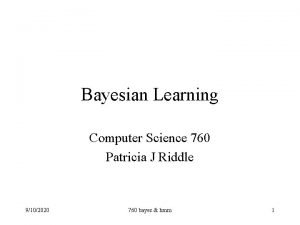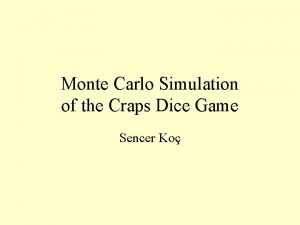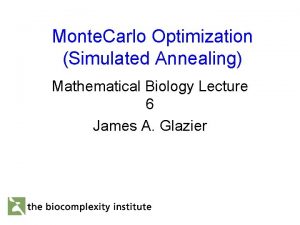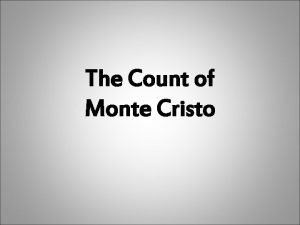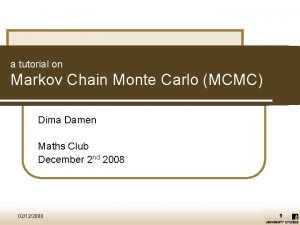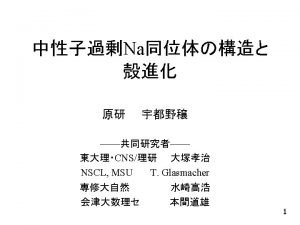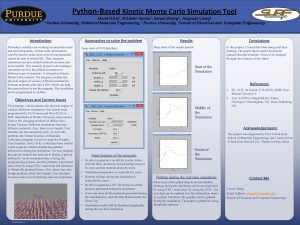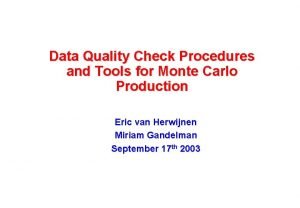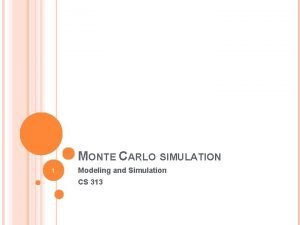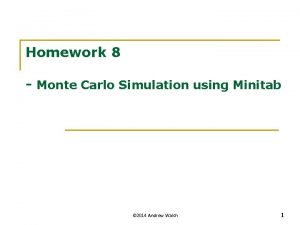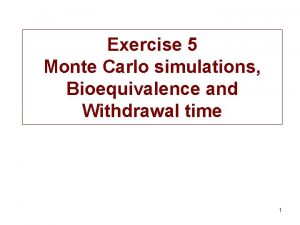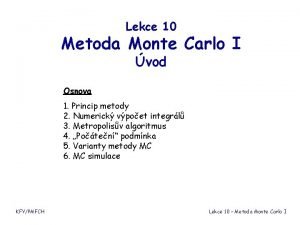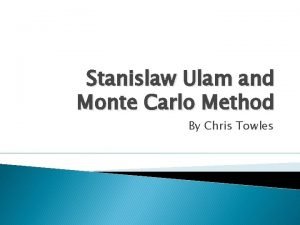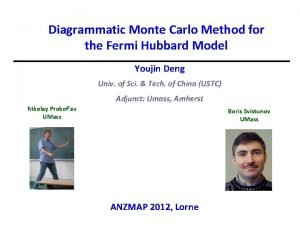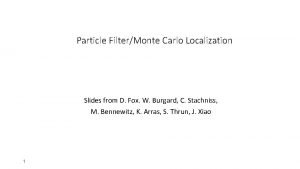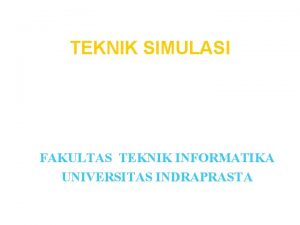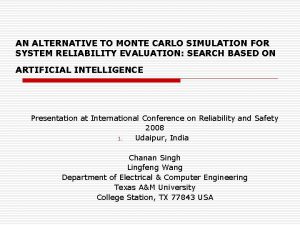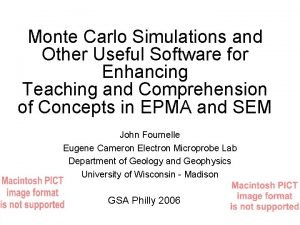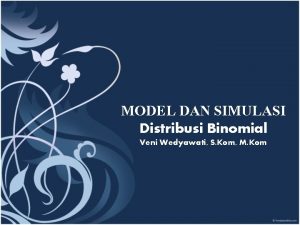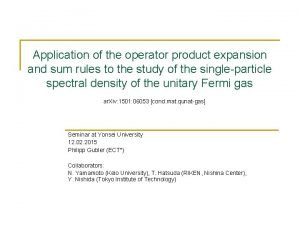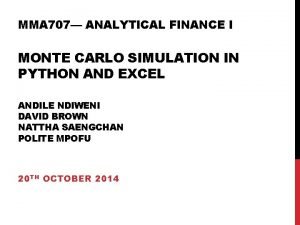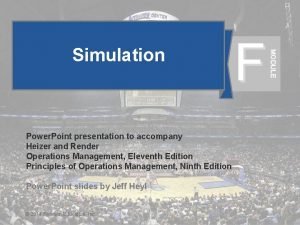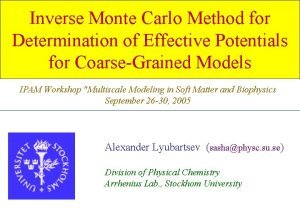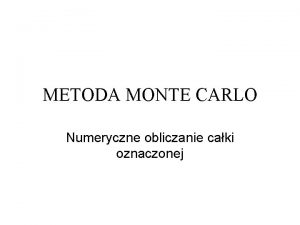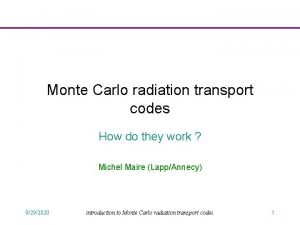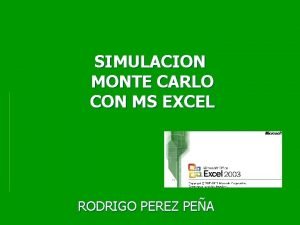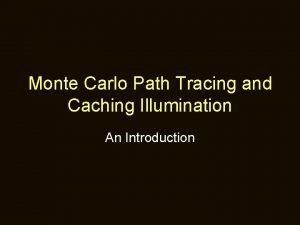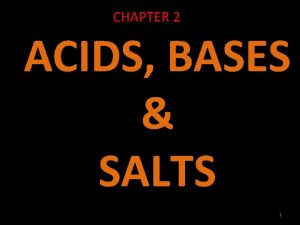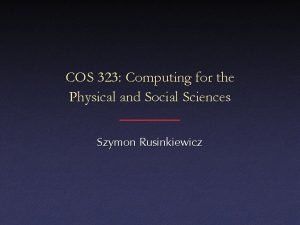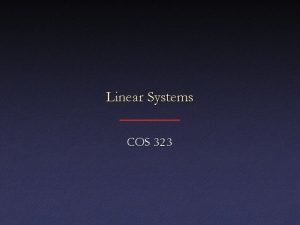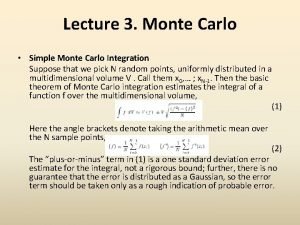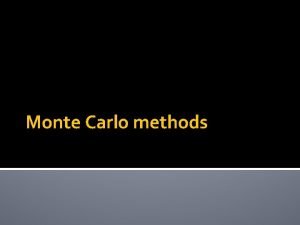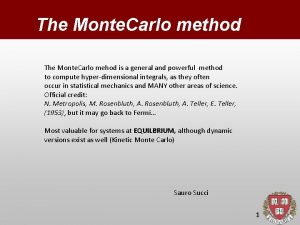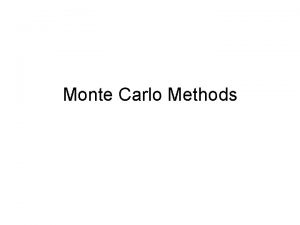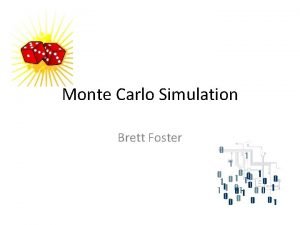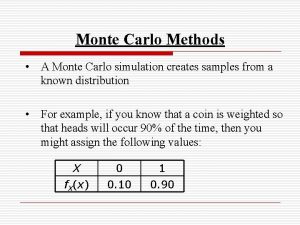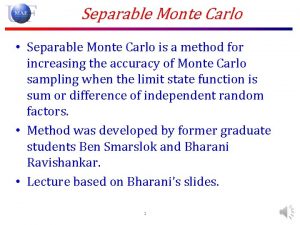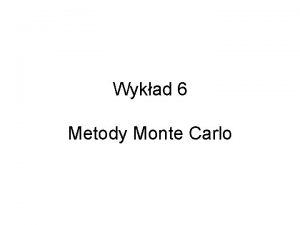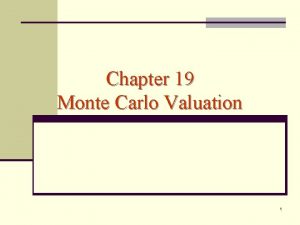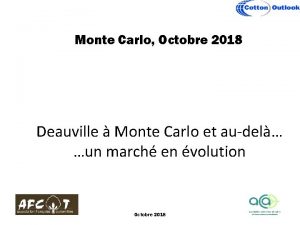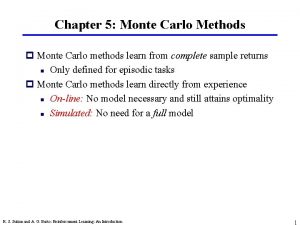Monte Carlo Integration COS 323 Acknowledgment Tom Funkhouser































![Rendering Equation Light Surface Viewer [Kajiya 1986] Rendering Equation Light Surface Viewer [Kajiya 1986]](https://slidetodoc.com/presentation_image_h/265c1368fe52b57fa2e35ad0ab52c398/image-32.jpg)





















- Slides: 53

Monte Carlo Integration COS 323 Acknowledgment: Tom Funkhouser

Integration in 1 D f(x) x=1 Slide courtesy of Peter Shirley

We can approximate f(x) g(x) x=1 Slide courtesy of Peter Shirley

Or we can average f(x) E(f(x)) x=1 Slide courtesy of Peter Shirley

Estimating the average f(x) E(f(x)) x 1 x. N Slide courtesy of Peter Shirley

Other Domains f(x) < f >ab x=a x=b Slide courtesy of Peter Shirley

Benefits of Monte Carlo • No “exponential explosion” in required number of samples with increase in dimension • Resistance to badly-behaved functions

Variance E(f(x)) x 1 x. N

Variance decreases as 1/N Error decreases as 1/sqrt(N) E(f(x)) x 1 x. N

Variance • Problem: variance decreases with 1/N – Increasing # samples removes noise slowly E(f(x)) x 1 x. N

Variance Reduction Techniques • Problem: variance decreases with 1/N – Increasing # samples removes noise slowly • Variance reduction: – Stratified sampling – Importance sampling

Stratified Sampling • Estimate subdomains separately Arvo E k(f(x)) x 1 x. N

Stratified Sampling • This is still unbiased E k(f(x)) x 1 x. N

Stratified Sampling • Less overall variance if less variance in subdomains E k(f(x)) x 1 x. N

Importance Sampling • Put more samples where f(x) is bigger E(f(x)) x 1 x. N

Importance Sampling • This is still unbiased E(f(x)) x 1 x. N for all N

Importance Sampling • Zero variance if p(x) ~ f(x) E(f(x)) x 1 x. N Less variance with better importance sampling

Generating Random Points • Uniform distribution: – Use pseudorandom number generator Probability 1 0 W

Pseudorandom Numbers • Deterministic, but have statistical properties resembling true random numbers • Common approach: each successive pseudorandom number is function of previous • Linear congruential method: – Choose constants carefully, e. g. a = 1664525 b = 1013904223 c = 232 – 1

Pseudorandom Numbers • To get floating-point numbers in [0. . 1), divide integer numbers by c + 1 • To get integers in range [u. . v], divide by (c+1)/(v–u+1), truncate, and add u – Better statistics than using modulo (v–u+1) – Only works if u and v small compared to c

Generating Random Points • Uniform distribution: – Use pseudorandom number generator Probability 1 0 W

Importance Sampling • Specific probability distribution: – Function inversion – Rejection

Importance Sampling • “Inversion method” – Integrate f(x ): Cumulative Distribution Function 1

Importance Sampling • “Inversion method” – Integrate f(x ): Cumulative Distribution Function – Invert CDF, apply to uniform random variable 1

Importance Sampling • Specific probability distribution: – Function inversion – Rejection

Generating Random Points • “Rejection method” – Generate random (x, y) pairs, y between 0 and max(f(x))

Generating Random Points • “Rejection method” – Generate random (x, y) pairs, y between 0 and max(f(x)) – Keep only samples where y < f(x)

Monte Carlo in Computer Graphics

or, Solving Integral Equations for Fun and Profit

or, Ugly Equations, Pretty Pictures

Computer Graphics Pipeline Modeling Animation Lighting and Reflectance Rendering
![Rendering Equation Light Surface Viewer Kajiya 1986 Rendering Equation Light Surface Viewer [Kajiya 1986]](https://slidetodoc.com/presentation_image_h/265c1368fe52b57fa2e35ad0ab52c398/image-32.jpg)
Rendering Equation Light Surface Viewer [Kajiya 1986]

Rendering Equation • This is an integral equation • Hard to solve! – Can’t solve this in closed form – Simulate complex phenomena Heinrich

Rendering Equation • This is an integral equation • Hard to solve! – Can’t solve this in closed form – Simulate complex phenomena Jensen

Monte Carlo Integration f(x) Shirley

Monte Carlo Path Tracing Estimate integral for each pixel by random sampling

Monte Carlo Global Illumination • Rendering = integration – Antialiasing – Soft shadows – Indirect illumination – Caustics

Monte Carlo Global Illumination • Rendering = integration – Antialiasing – Soft shadows – Indirect illumination – Caustics Eye Pixel x Surface

Monte Carlo Global Illumination • Rendering = integration – Antialiasing – Soft shadows – Indirect illumination – Caustics Light Eye x Surface x’

Monte Carlo Global Illumination • Rendering = integration – Antialiasing – Soft shadows – Indirect illumination – Caustics Herf

Monte Carlo Global Illumination Surface • Rendering = integration – Antialiasing – Soft shadows – Indirect illumination – Caustics Light Eye w’ w x Surface

Monte Carlo Global Illumination • Rendering = integration – Antialiasing – Soft shadows – Indirect illumination – Caustics Debevec

Monte Carlo Global Illumination Specular Surface • Rendering = integration – Antialiasing – Soft shadows – Indirect illumination – Caustics Eye w w’ x Diffuse Surface Light

Monte Carlo Global Illumination • Rendering = integration – Antialiasing – Soft shadows – Indirect illumination – Caustics Jensen

Challenge • Rendering integrals are difficult to evaluate – Multiple dimensions – Discontinuities • Partial occluders • Highlights • Caustics Drettakis

Challenge • Rendering integrals are difficult to evaluate – Multiple dimensions – Discontinuities • Partial occluders • Highlights • Caustics Jensen

Monte Carlo Path Tracing Big diffuse light source, 20 minutes Jensen

Monte Carlo Path Tracing 1000 paths/pixel Jensen

Monte Carlo Path Tracing • Drawback: can be noisy unless lots of paths simulated • 40 paths per pixel: Lawrence

Monte Carlo Path Tracing • Drawback: can be noisy unless lots of paths simulated • 1200 paths per pixel: Lawrence

Reducing Variance • Observation: some paths more important (carry more energy) than others – For example, shiny surfaces reflect more light in the ideal “mirror” direction • Idea: put more samples where f(x) is bigger

Importance Sampling • Idea: put more samples where f(x) is bigger

Effect of Importance Sampling • Less noise at a given number of samples Uniform random sampling Importance sampling • Equivalently, need to simulate fewer paths for some desired limit of noise
 Monte carlo integration matlab
Monte carlo integration matlab Monte carlo simulation particle physics
Monte carlo simulation particle physics Contoh simulasi monte carlo
Contoh simulasi monte carlo Continuous time monte carlo
Continuous time monte carlo The monte carlo
The monte carlo Monte carlo vs temporal difference
Monte carlo vs temporal difference Villa monte carlo
Villa monte carlo Viterbi algorithm
Viterbi algorithm Monte carlo simulation dice roll matlab
Monte carlo simulation dice roll matlab Monte carlo truth
Monte carlo truth Monte carlo localization for mobile robots
Monte carlo localization for mobile robots Monte carlo exercise
Monte carlo exercise Monte carlo optimization
Monte carlo optimization Count of monte carlo
Count of monte carlo 1:77:1
1:77:1 Markov chain monte carlo tutorial
Markov chain monte carlo tutorial Monte carlo sd
Monte carlo sd Kinetic monte carlo python
Kinetic monte carlo python Monte carlo data quality
Monte carlo data quality Monte carlo search tree
Monte carlo search tree Monte carlo szimuláció példa
Monte carlo szimuláció példa Monte carlo simulation
Monte carlo simulation Monte carlo minitab
Monte carlo minitab Monte carlo exercise
Monte carlo exercise Metoda monte carlo
Metoda monte carlo Stanislaw ulam
Stanislaw ulam Diagrammatic monte carlo
Diagrammatic monte carlo Monte carlo localization python
Monte carlo localization python Bilangan random adalah
Bilangan random adalah Alternative to monte carlo simulation
Alternative to monte carlo simulation Mcts tutorial
Mcts tutorial Monte carlo simulation freeware
Monte carlo simulation freeware Contoh soal binomial heap
Contoh soal binomial heap Quantum monte carlo
Quantum monte carlo Monte carlo simulation
Monte carlo simulation Monte carlo simulation advantages and disadvantages ppt
Monte carlo simulation advantages and disadvantages ppt Inverse monte carlo
Inverse monte carlo Simulasi monte carlo ppt
Simulasi monte carlo ppt Metoda monte carlo algorytm
Metoda monte carlo algorytm Monte carlo radiation transport
Monte carlo radiation transport Distribucion binomial excel
Distribucion binomial excel Bushy hair
Bushy hair Eric veach thesis
Eric veach thesis Baking soda acid or base
Baking soda acid or base Acknowledgment
Acknowledgment Acknowledgments
Acknowledgments Acknowledgement slides
Acknowledgement slides Cos 323
Cos 323 Cos 323
Cos 323 Cos 323°
Cos 323° Cos 323
Cos 323 Cos 323
Cos 323 Cos 323
Cos 323 Cos 323°
Cos 323°

